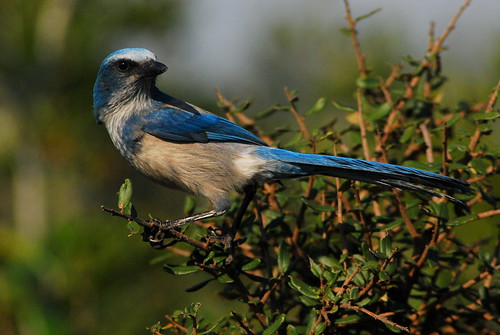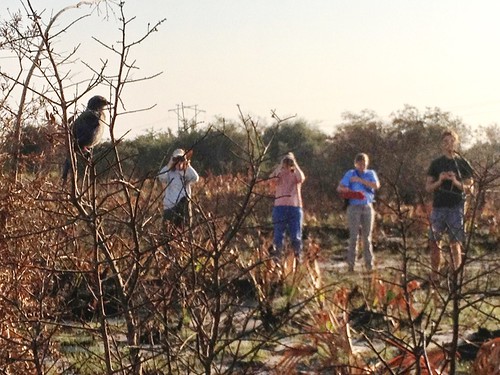*** This cache is part of the Taking Flight GeoTour. Anyone can claim this cache, but to be eligible to receive a Taking Flight GeoTour prize tag, geocachers must complete the activities in this survey for at least 12 caches on the tour.***
Duette Preserve's walk-through gates are open daily from sunrise to sunset to pedestrian, bicycle and equestrian traffic. To enter Duette Preserve by vehicle, you must visit during office hours. Hours: Saturdays, 11:30 a.m. - 2:30 p.m. • Fee: $4.67 per vehicle, plus tax. Four-wheel drive is recommended if visiting by vehicle as trails may be flooded during seasons of heavy rainfall. Duette Preserve is closed during hunt weekends. Be sure to check the hunt schedule before visiting the preserve.
Welcome to the scrub! The land here is one of the oldest ecosystems in Florida, a remnant of the ancient sand dunes when much of modern day Florida was covered in water. Careful observers will notice that the habitat here has few tall trees; rather there is a low canopy of oak trees, some mid-sized shrubs, and a lot of low ground cover. Keep an eye out for wildlife – many rare and unusual creatures can be found here including gopher tortoises and indigo snakes. The soil here is very dry and well-drained, making many of the plants that grow here rare too. In fact, over half of the plants and animals that are found here are so rare that they are endemic, or found nowhere else in the world. One animal in particular, the Florida scrub-jay, has become the spokes bird for this rare and rapidly disappearing habitat.

Florida scrub jay at Duette Preserve. Photo by Lauren Deaner
This beautiful blue and gray scrub-jay is only found in the Florida scrub and is considered to be a Threatened species under the Endangered Species Act. Scrub jays are quite clever, living in tight-knit family groups that work together to help one another survive. The groups stage sentry birds to look out for any troublesome predators like hawks or snakes. Older birds from past years' nests will remain with the breeding pair year round to help the parents raise their young and defend the territory. Once the helpers are old enough (2-3 years old) they will leave the group in search of a mate and a territory. They will eat anything from insects, snakes, and frogs to their absolute favorite food of acorns and are even better than squirrels at saving acorns for the colder winter months. How can a bird that is a supreme survivalist in the scrub be disappearing?
The disappearance of the scrub-jay is linked directly with our own love of living high and dry. Scrub habitat is some of the best land to build upon, and much of the jays’ habitat has been transformed into homes or agricultural areas for humans. The jays need the scrub habitat for their home, but they also need a large acreage and regular fires in the landscape to keep the scrub oak trees at the low level they prefer. David Gordon, the scientist from Quest Ecology who helps track and study Duette’s jay population, explains ‘Without large tracts of scrub that are burned regularly to maintain the low structure provided by scrub oaks, jays will go extinct in those regions. The situation is dire for the scrub jays and even though this bird was listed as Threatened in 1987 its numbers have fallen range wide every year since then.'
But there is hope! Duette Preserve’s scrub habitat restoration is a great example of a successful attempt to restore and manage the scrub-jays’ preferred land habitat. This area was overgrown and suffered from years of fire exclusion and suppression. Through the use of prescribed fire management and the removal of the taller trees, the habitat became prime scrub-jay territory. In 1997 Duette’s jays were predicted to go extinct, but now there are more than 15 families living throughout the preserve! Each year, volunteers help to count the jays within one small area, at the cache site, in order to track the arrival of new jays and bird families are literally flocking to the site!

Jay Watch 2012 volunteers spot a scrub jay. Photo by Melissa Nell
Visit the sites along the Taking Flight GeoTour (TFGT) and learn about Manatee County's wild spaces and the amazing feathered friends that live in them. Along the way, you will be challenged to become a citizen scientist, a preserve ranger, a detective, a historian, an excellent geocacher. Caches are located in birding hot spots throughout Manatee County's publicly accessible conservation Preserves. Each one highlights a specific bird species or aspect of bird life providing you with opportunities to learn more about these creatures and what we can do to help them survive. Caches also focus on protecting the region's waterways, bays, natural watersheds, and habitat areas for many of our area's feathered friends.
The Taking Flight GeoTour launched August 20, 2012 and includes 18 caches within Manatee County.
To be eligible to receive a Taking Flight GeoTour prize tag, geocachers must complete the activities in this survey for at least 12 finds on the tour. Keep this survey open in your browser, only click submit when at least 12 finds have been completed. Survey responses will be automatically sent to Manatee County staff. Prize tags can be redeemed on Saturday mornings from 9am - 12pm at The NEST at Robinson Preserve located at 840 99th St NW, Bradenton, FL 34209. If you are unable to collect your prize tag in person, please contact ecoevents@mymanatee.org to arrange for your tag to be sent in the mail. Tags will be available while supplies last.
Thank you for assisting with the Taking Flight GeoTour: